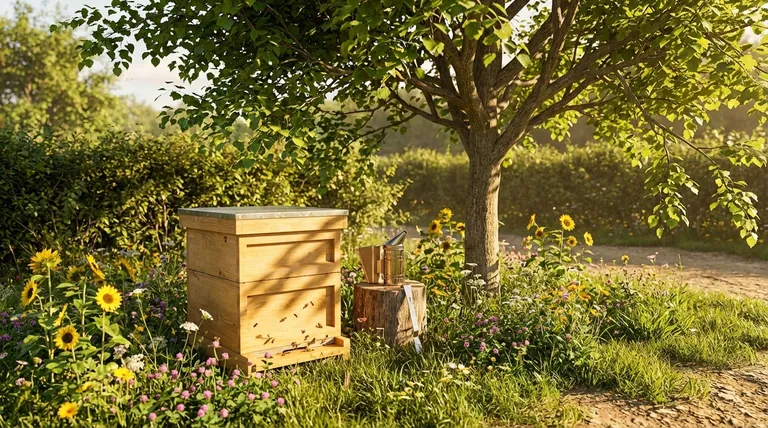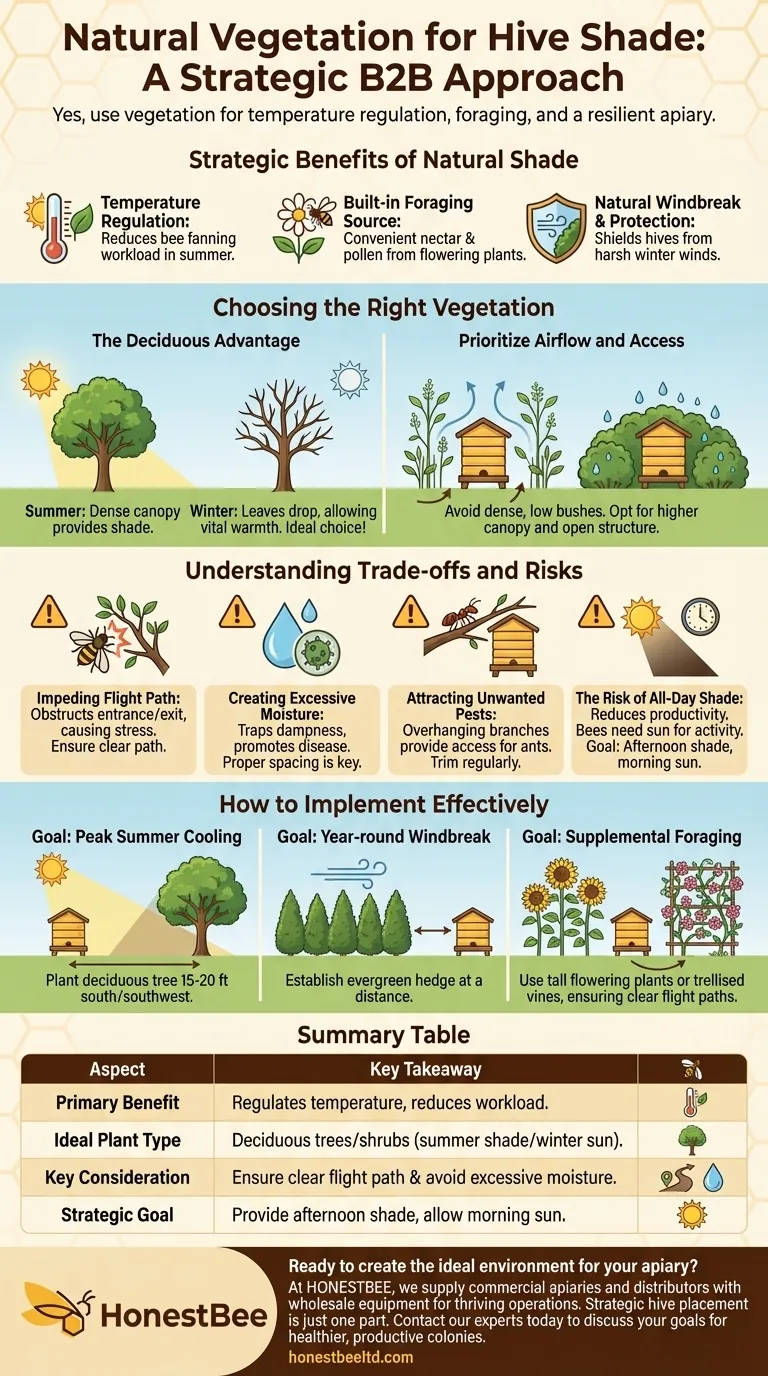Yes, you can and often should use natural vegetation for hive shade. This approach not only helps regulate the hive's temperature during hot months but can also provide a valuable, nearby food source for your bees, creating a more integrated and beneficial micro-environment.
The goal is not simply to create shade, but to strategically manage sunlight. The best natural vegetation provides cooling relief from the intense afternoon sun in the summer while still allowing crucial warmth from the sun during the morning and in cooler seasons.

The Strategic Benefits of Natural Shade
Using plants to shade your hives goes beyond simple temperature control. It creates a more dynamic and resilient apiary environment.
Temperature Regulation without Overcooling
A primary challenge for a colony in the summer is thermoregulation. Bees expend significant energy and water fanning the hive to prevent the brood and wax from overheating.
Properly placed vegetation provides dappled shade, especially during the hottest part of the day (afternoon), which dramatically reduces this workload. This allows the bees to redirect their energy toward foraging and honey production.
A Built-in Foraging Source
Choosing the right plants offers a dual benefit. Taller flowering plants, shrubs, or trees can provide both shade and a convenient source of nectar and pollen.
This proximity reduces the energy your bees must expend to find food, contributing to a stronger, more productive colony.
Natural Windbreak and Protection
In addition to shade, a strategic planting of shrubs or a hedgerow can serve as an effective windbreak. This protects the hive from harsh winter winds and prevents the entrance from being battered by storms, making it easier for bees to maintain a stable internal temperature year-round.
Choosing the Right Vegetation
The type of plant and its placement are the most critical factors for success. An improperly chosen or placed plant can cause more harm than good.
The Deciduous Advantage
For most climates, deciduous trees or large shrubs are the ideal choice. They provide a dense canopy for shade during the hot summer months.
In the winter, they drop their leaves, allowing the vital winter sun to reach the hive. This passive solar gain helps keep the colony warm and encourages cleansing flights on milder days.
Prioritize Airflow and Access
Avoid dense, low-growing bushes planted directly against the hive. These can trap moisture, promote mold and mildew, and block the bees' flight path.
Opt for plants with a higher canopy or a more open structure that allows for clear airflow around the hive and unimpeded access for both the bees and the beekeeper.
Understanding the Trade-offs and Risks
While beneficial, using natural vegetation requires careful management to avoid common pitfalls.
Impeding the Flight Path
The most immediate risk is obstructing the bees' entrance and exit. Bees establish clear "bee lines" to and from the hive. Any branches or leaves in this direct path will cause congestion, stress, and disorientation.
Always ensure the front of the hive has a clear, unobstructed path for several feet.
Creating Excessive Moisture
A hive needs to be dry. Vegetation that is too close, especially on the morning-sun side, can prevent dew from evaporating, leading to a damp environment.
This dampness can promote fungal diseases like chalkbrood and make it harder for the colony to stay warm. Proper spacing and good airflow are essential to mitigate this.
Attracting Unwanted Pests
Overhanging branches can become a literal bridge for pests like ants to gain easy access to the hive.
Regularly trim back any limbs that touch the hive. This simple maintenance step eliminates a major pathway for invaders.
The Risk of All-Day Shade
A hive that is in deep shade all day will be less productive. Bees are more active in the sun, and the warmth is critical for brood development.
The ideal setup provides shade from the intense midday and afternoon sun (from the south and west in the Northern Hemisphere) but allows for direct morning sunlight to warm the hive and encourage activity.
How to Implement Natural Shade Effectively
Your choice of vegetation should be directly tied to your specific goals for the apiary and your local climate.
- If your primary focus is peak summer cooling: Plant a deciduous tree 15-20 feet to the south or southwest of your hive to cast afternoon shade.
- If your primary focus is a year-round windbreak: Establish a row of evergreen shrubs or a hedge a good distance away from the hives, particularly on the side that receives prevailing winter winds.
- If your primary focus is supplemental foraging: Use tall flowering plants like sunflowers or climbing vines on a trellis positioned to the side of the hive, ensuring they do not block flight paths.
Ultimately, integrating natural vegetation is about creating a balanced ecosystem that supports your bees' health and productivity.
Summary Table:
| Aspect | Key Takeaway |
|---|---|
| Primary Benefit | Regulates hive temperature and reduces bee workload. |
| Ideal Plant Type | Deciduous trees/shrubs for summer shade and winter sun. |
| Key Consideration | Ensure clear flight path and avoid excessive moisture. |
| Strategic Goal | Provide afternoon shade while allowing morning sun. |
Ready to create the ideal environment for your apiary?
At HONESTBEE, we supply commercial apiaries and beekeeping equipment distributors with the wholesale supplies needed to build and maintain thriving operations. Strategic hive placement is just one part of a successful beekeeping business.
Contact our experts today to discuss how our high-quality equipment and supplies can support your goals for healthier, more productive colonies.
Visual Guide

Related Products
- HONESTBEE Professional Long Handled Hive Tool with Precision Cutting Blade
- HONESTBEE Advanced Ergonomic Stainless Steel Hive Tool for Beekeeping
- Professional Dual-End Stainless Steel Hive Tool for Beekeeping
- Long Langstroth Style Horizontal Top Bar Hive for Wholesale
- Wholesales Dadant Size Wooden Bee Hives for Beekeeping
People Also Ask
- What are some common uses of a hive tool? Essential Multi-Purpose Tool for Every Beekeeper
- What are the features of a regular hive tool? The Essential Multi-Tool for Every Beekeeper
- How should beekeepers handle bees when using a hive tool? Master Calm, Deliberate Techniques
- What is the hive tool used for? The Essential Multi-Tool for Every Beekeeper
- What is a hive tool used for in beekeeping? Your Essential Guide to Hive Management



















